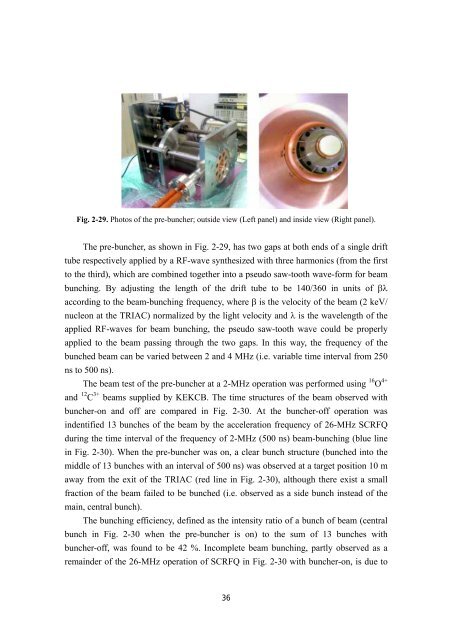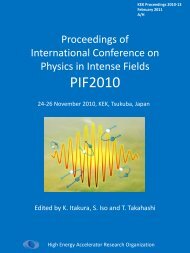TRIAC Progress Report - KEK
TRIAC Progress Report - KEK
TRIAC Progress Report - KEK
You also want an ePaper? Increase the reach of your titles
YUMPU automatically turns print PDFs into web optimized ePapers that Google loves.
Fig. 2-29. Photos of the pre-buncher; outside view (Left panel) and inside view (Right panel).<br />
The pre-buncher, as shown in Fig. 2-29, has two gaps at both ends of a single drift<br />
tube respectively applied by a RF-wave synthesized with three harmonics (from the first<br />
to the third), which are combined together into a pseudo saw-tooth wave-form for beam<br />
bunching. By adjusting the length of the drift tube to be 140/360 in units of βλ<br />
according to the beam-bunching frequency, where β is the velocity of the beam (2 keV/<br />
nucleon at the <strong>TRIAC</strong>) normalized by the light velocity and λ is the wavelength of the<br />
applied RF-waves for beam bunching, the pseudo saw-tooth wave could be properly<br />
applied to the beam passing through the two gaps. In this way, the frequency of the<br />
bunched beam can be varied between 2 and 4 MHz (i.e. variable time interval from 250<br />
ns to 500 ns).<br />
The beam test of the pre-buncher at a 2-MHz operation was performed using 16 O 4+<br />
and 12 C 3+ beams supplied by <strong>KEK</strong>CB. The time structures of the beam observed with<br />
buncher-on and off are compared in Fig. 2-30. At the buncher-off operation was<br />
indentified 13 bunches of the beam by the acceleration frequency of 26-MHz SCRFQ<br />
during the time interval of the frequency of 2-MHz (500 ns) beam-bunching (blue line<br />
in Fig. 2-30). When the pre-buncher was on, a clear bunch structure (bunched into the<br />
middle of 13 bunches with an interval of 500 ns) was observed at a target position 10 m<br />
away from the exit of the <strong>TRIAC</strong> (red line in Fig. 2-30), although there exist a small<br />
fraction of the beam failed to be bunched (i.e. observed as a side bunch instead of the<br />
main, central bunch).<br />
The bunching efficiency, defined as the intensity ratio of a bunch of beam (central<br />
bunch in Fig. 2-30 when the pre-buncher is on) to the sum of 13 bunches with<br />
buncher-off, was found to be 42 %. Incomplete beam bunching, partly observed as a<br />
remainder of the 26-MHz operation of SCRFQ in Fig. 2-30 with buncher-on, is due to<br />
36













